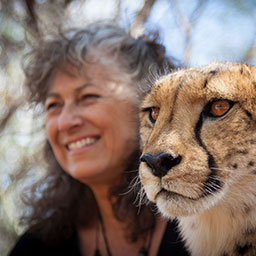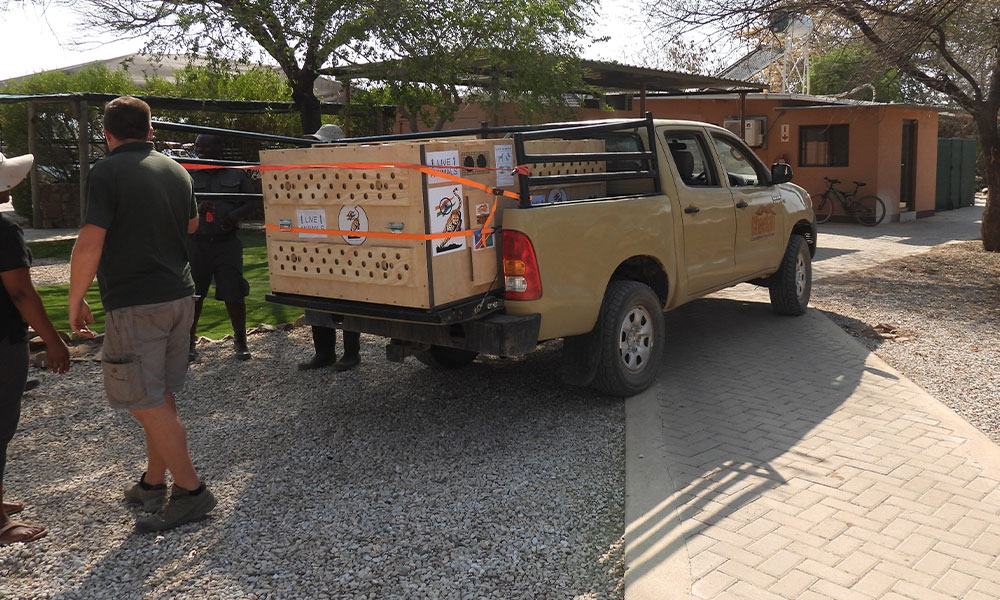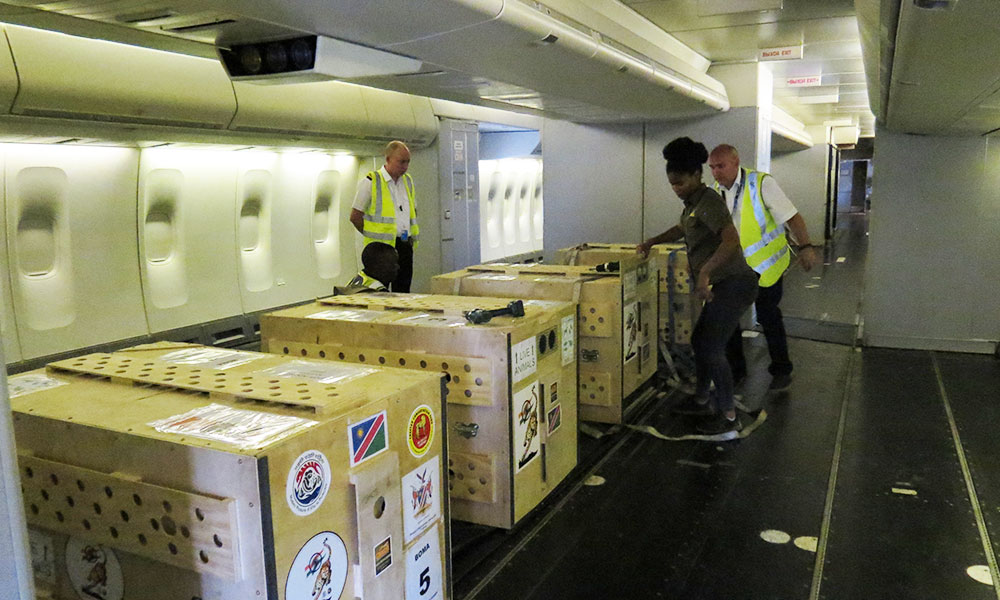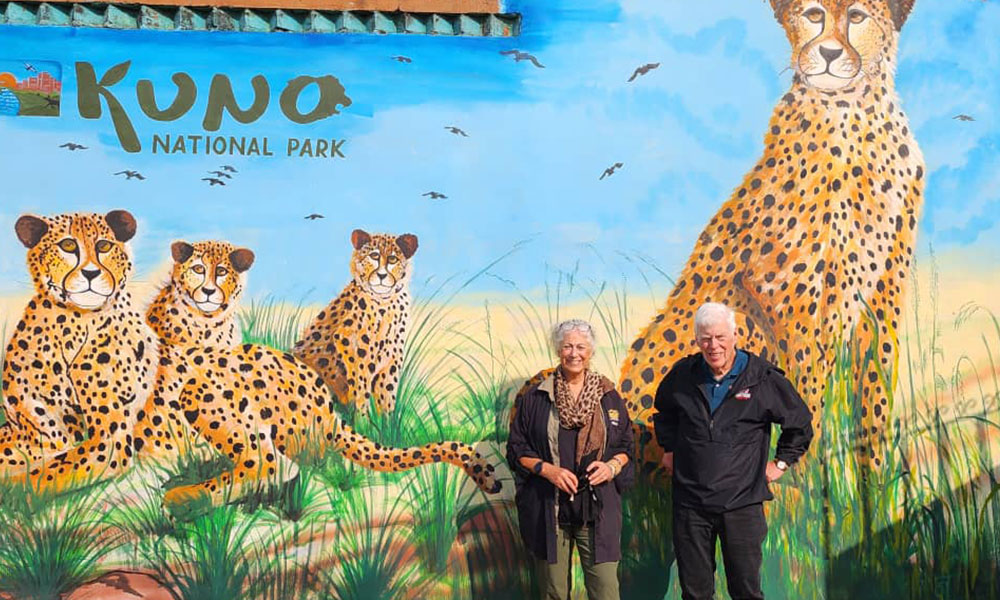Project Cheetah Update – First Anniversary
-

- by Dr. Laurie Marker August 22, 2023

Reflecting on One Year of Project Cheetah: Challenges, Collaboration, and Conservation
As September 17th approaches, we stand at a significant juncture, marking the one-year anniversary of Project Cheetah, the reintroduction project between India, Namibia and South Africa to reintroduce cheetahs back into India after having been extinct for over 70 years. Over the past year, this collaborative endeavor has been a journey of challenges, successes, and most importantly, lessons that underscore the intricate nature of multinational conservation initiatives. The Cheetah Conservation Fund (CCF), which I founded and serve as the Executive Director, is not the owner of this project but has been intricately involved as an advisory partner, helping guide the project’s path forward.
Pioneering Cheetah Survival:
Project Cheetah’s central objective of ensuring cheetah survival, transcends national boundaries. With a stronghold in southern Africa, the rangewide cheetah population is fewer than 7,500 and dwindling. Habitats are disappearing at a rapid rate, but this initiative serves as a beacon of hope, reminding us of our responsibility to conserve the species. The challenges we face are emblematic of broader conservation issues that demand a united global response. We need to stop losing the species in its current range and bring it back to its former range.
From Namibia’s founding in 1990, a robust conservation framework was built into its constitution, something rarely seen in other countries around the world. The elected representatives and officials of the ministries of Namibia consider India to be a good partner in Project Cheetah. So do we.
The government of India adopts, implements and enforces environmental legislation under the Ministry of Environment, Forest, and Climate Change. In collaboration with Madhya Pradesh Forest Department, Wildlife Institute of India, and the National Tiger Conservation Authority an ambitious Action Plan for Introduction of Cheetah in India was published in January 2022. The 310 page document and the plan outlined within it, took 12 years to come to fruition. We’ve been involved with the research, development and implementation since the beginning along with many others. Namibia and India would never have reached an agreement without very careful considerations on ALL levels. We believe in this project.


Navigating Unforeseen Challenges:
The past year has been marked by challenges that have tested our resolve and pushed us to innovate. What seemed to be collar-related complications, causing the deaths of three released cheetahs, may have actually been problems that began with ticks. This is something that in CCF’s 33 years of using tracking collars on cheetahs, we have never seen. Thankfully with further investigation, we may find a preventative solution in applications of longer lasting anti-parasitic medications.
Cub mortality in the first litter of cheetahs born in India in 70+ years, reminded us that conservation is not an easy journey; there are unexpected twists, turns and many setbacks. Sometimes the soft skills none of us were trained for like open-mindedness, reasoning, patience and resolve, become our most valuable resources. With cheetah cubs facing a 30% mortality rate in captivity and up to a 90% mortality rate in the wild, and the wild population still in decline, we are keenly aware of the preciousness of each new cub.
Factors like the inexperience of a first-time mother, heat and humidity can take their toll very quickly on newborn animals. Even the most experienced vets can sometimes miss a critical behavioral cue. Animal keepers and managers are sometimes more connected to reading an animal’s behaviors and can sense a problem even before it is registered on a reading. This is why our team is highly diverse in training and expertise. We feel a shared responsibility for the losses and we feel each loss very keenly.
CCF’s on-the-ground representatives are two staff members, Barth Balli and Eli Walker. They are both specialists in reintroduction and rehabilitation and they are very highly-trained. Barth is a registered veterinary technician who has extensive knowledge of field-based veterinary care and Eli has specialized in cheetah management and veterinary care for over 15 years. Since the project began last year, CCF has had a presence on the ground for all but two months total. Our primary role is to advise and teach when needed – we are available and ready to assist whenever we are asked for assistance. The whole Project Cheetah team is invested in the success of this reintroduction.


Transparency and the Media Landscape:
From the moment the agreement between India and Namibia was signed, the global awareness of the plight of the cheetah was elevated to international news. We saw a renewed interest in conserving not just the cheetah but our planet’s many endangered species and their vital habitats.
Our experience with media coverage over the past year has highlighted the need for transparency and accurate reporting. Project Cheetah has been good for network ratings – especially when the news is bad. Many times we’ve seen a rush and demand to publish anything related to the project. This can cause incomplete or initial findings to be presented as conclusive. We’ve seen many instances where speculations or complete fabrications are presented as facts.
CCF’s role in Project Cheetah’s communications team is to follow India’s lead as the owners of this project. After they have presented news updates to the press on their terms, we usually follow-up by providing context and clarity to stories and posts we see published online. I’ve spoken very openly to the press on many occasions alongside other participants from South Africa and representatives of the government of Namibia and Kuno National Park.
As we approach this anniversary, it’s imperative that we continue to communicate openly and transparently. Addressing misconceptions and providing accurate information remains a top priority as we navigate the complex media and social media landscape. We hope you will continue to follow along using the hashtags #ProjectCheetah #SaveTheCheetah and at our social media pages @CCFCheetah.
Charting a Path Forward:
As we embark on the project’s second year, our focus remains resolute: to ensure the cheetah’s survival, in the wild, in India. The collaborative spirit shared by India, Namibia and South Africa, guided by CCF’s advisory role, will continue to shape the project’s trajectory. Adapting strategies, addressing challenges head-on, and fostering meaningful partnerships will remain the keys to our success.

A Global Call to Action:
The first anniversary will hopefully stand as a global call to action. Project Cheetah exemplifies how nations can come together to address the formidable challenges of conservation. The survival of the cheetah is not a responsibility that falls solely on one country’s citizens or one NGO’s fundraisers. We must share a commitment to protecting biodiversity on a global scale before there are no more cheetahs left.
In closing, as we approach the one-year milestone of Project Cheetah we celebrate not just a year’s progress, but a year of unified commitment, unyielding determination, and unwavering hope. With the collective support of all those who value our planet’s biodiversity, we move forward with renewed vigor, on our journey to save the cheetah in the wild.
Related Reading
-
November 24, 2025
Tupuka’s Wild Life



